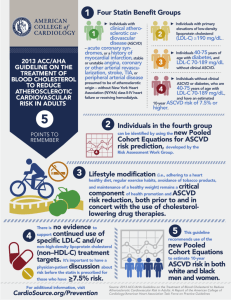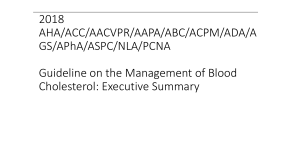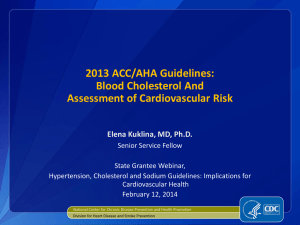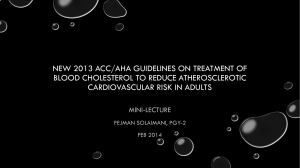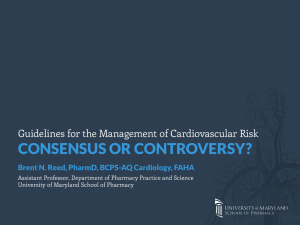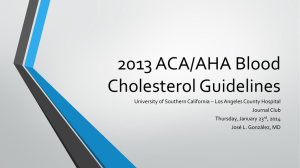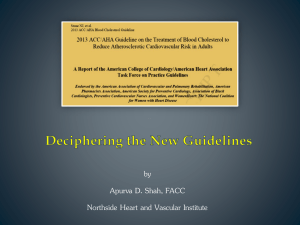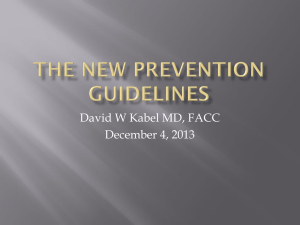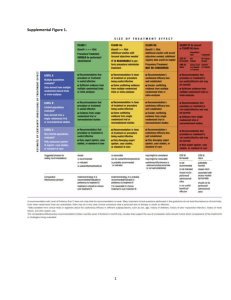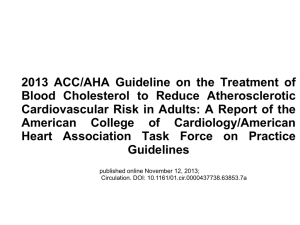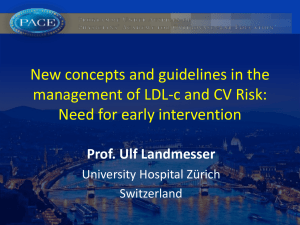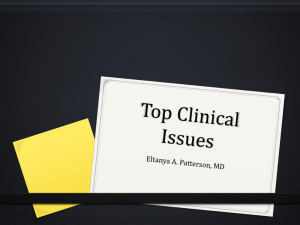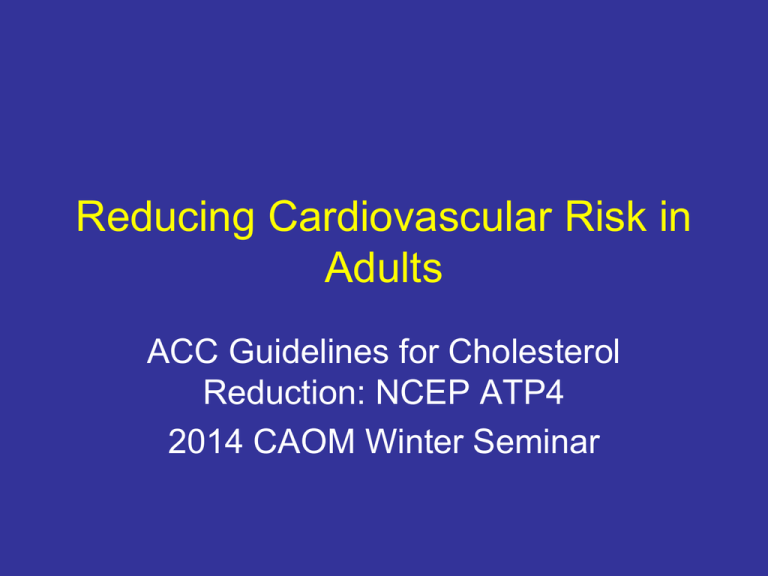
Reducing Cardiovascular Risk in
Adults
ACC Guidelines for Cholesterol
Reduction: NCEP ATP4
2014 CAOM Winter Seminar
A Roadmap: Defining the Problem,
Implementing Solutions
• Discuss U.S. Healthcare costs, outcomes,
and longevity
• Cardiovascular disease: driving healthcare
costs, morbidity, and mortality
• Overview of ACC/AHA cholesterol
treatment guidelines: 2013 ATP4
• Cardiac calcium scores, CTA
• Therapeutic Lifestyle Change
21st Century US Cardiovascular Risk
1. Cardiovascular disease (CVD): Leading cause
of death in the US.
2. 725,000 deaths in 2002
3. 1.2 million total AMI’s
4. Initial presentation of up to 50% of people is MI
or sudden death
21st Century US Cardiovascular
Costs
• 40 million noninvasive cardiac exams/yr
• 20% annual growth rate in noninvasive
tests
• Cardiac imaging consumes enormous
percentage of annual Medicare budget ~
$740,000,000
2012 Ohio Rank: #35
What you can’t yet see can hurt you
Atherosclerotic Plaque
Glagov’s Model
Angiography Cannot Account for
Coronary Remodeling
3.1 mm
3.1 mm
IVUS Image: Ruptured Coronary Plaque
Door to Balloon Time
(D2BTime)
• Time from a person entering the ER
(Door) to successful angioplasty balloon
inflation (Balloon).
• ACC and AHA Goals:
•
LakeWest 90 minutes
•
Tripoint 120 minutes
• Short D2B times improve survival and
quality of life, better heart function
The Story of L.C.
• How Snow covered drives and Loving wives
can save a Man’s Life
• 62 y/o with prior MI, cardiac arrest, excess
body weight, HTN, hyperlipidemia (treated)
• Severe chest pressure and SOB shoveling
his driveway, 30 minutes later with ongoing
pain, he tells his wife who calls EMS. Then
he passes out briefly.
The Story of L.C.
• EMS takes ECG showing ongoing heart
attack, transmitted to LakeWest ER.
• ER initiates ‘Code STEMI’ while patient
being transported to assemble the cardiac
cath lab team, interventional cardiologist,
CCU nursing staff.
• Upon ER arrival, drug therapy started and
emergent transport to cath lab.
Angiography Cannot Account for
Coronary Remodeling
3.1 mm
3.1 mm
ACS Pharmacology Options
• Aspirin, Plavix or Effient, G2B3A inhibitors,
Angiomax
• Heparin or lovenox antithrombins.
• Beta blockers, ACE-I, statins, for plaque
stabilization, inflammation reduction,
favorable ventricular remodeling
Reperfusion Strategies: Primary PTCA
versus Thrombolysis
• Normal flow in coronary artery(TIMI 3) is
goal of reperfusion-best myocardial
salvage
• Thrombolysis restores TIMI 3 flow 54%,
with early(10%)/ late(30%) reocclusion.
• Primary PTCA restores TIMI 3 flow 9397%, and is superior re: death,
CVA,reinfarction(GUSTO 2,PAMI)
Coronary Stent Technology
• Stainless steel, cobalt chromium, nitinol
scaffolds
• Mounted on PTCA balloon, deployed to
vessel size to prevent recoil/flap occlusion
• Restenosis is major shortcoming, coronary
lumen renarrowing from smooth muscle
cell migration and hypertrophy
Healing
Late Loss in Bare Metal Stents
• Late loss in bare metal stents is typically 1.0mm
• Late loss is thought to be largely comprised of neointima
• Late loss is nearly always a positive number, indicating the lumen
decreases in size
0.50mm
MLD post-procedure
MLD follow-up
+
0.50mm
Illustrations by Boston Scientific. Images not to scale.
Late Loss
1.0mm
Drug Eluting Stent Technology (DES)
• Revolutionary stents with drug and
polymer coatings
• Inhibit restenosis, esp. in diabetics, long
lesions, small vessels
• 2 FDA approved DES types in US:
• Sirolimus
• Paclitaxel
• Future: multiple stents and coatings
L.C. and the Rest of the Story
D2B Time 66 minutes.
Echo shows small amount of damage with
overall normal heart function.
Medications optimized.
Cardiac rehab and wellness referrals.
Recommend: Leave the snow on your drive,
Take your wife to dinner weekly.
Major Cardiovascular Risk
Factors
•
•
•
•
•
•
Age
Gender
Smoking
Diabetes
High LDL
Low HDL
Obesity
Sedentary lifestyle
HTN(140/90) or treated
Family history premature
CVD(F<65,M<55)
Features of ATP III :
Aggressive Treatment
Guidelines
Modification of Lipid and Lipoprotein
Classification
• LDL cholesterol <70-80 mg/dL—optimal
• HDL cholesterol >40 mg/dL
– Categorical risk factor
– Raised from >35 mg/dL
• Lower triglyceride classification cut points
(<150)
– More attention to moderate elevations
10 Points to Remember on the
Treatment of Blood Cholesterol to
Reduce Atherosclerotic
Cardiovascular Risk in Adults
Summary Prepared by Melvyn Rubenfire, MD
Point 1
The 2013 ACC/AHA Expert Panel included all 16
members of the National Heart, Lung, and Blood
Institute Adult Treatment Panel (ATP) IV, and the
document review included 23 expert reviewers and
representatives of federal agencies. The expert
panel recommendations arose from careful
consideration of an extensive body of higher
quality evidence derived from randomized
controlled trials (RCTs), and systematic reviews
and meta-analyses of RCTs.
Point 2
Through a rigorous process, four groups of individuals were
identified for whom an extensive body of RCT evidence
demonstrated a reduction in atherosclerotic cardiovascular
disease (ASCVD) events (including coronary heart disease
[CHD], cardiovascular deaths, and fatal and nonfatal
strokes) with a good margin of safety from statin therapy:
Point 2 (cont.)
Four Statin Benefit Groups:
•Individuals with clinical ASCVD (acute coronary syndromes, or a
history of MI, stable or unstable angina, coronary or other arterial
revascularization, stroke, TIA, or peripheral arterial disease presumed
to be of atherosclerotic origin ) without New York Heart Association
(NYHA) class II-IV heart failure or receiving hemodialysis.
•Individuals with primary elevations of low-density lipoprotein
cholesterol (LDL-C) ≥190 mg/dl.
•Individuals 40-75 years of age with diabetes, and LDL-C 70-189 mg/dl
without clinical ASCVD.
•Individuals without clinical ASCVD or diabetes, who are 40-75 years of
age with LDL-C 70-189 mg/dl, and have an estimated 10-year ASCVD
risk of 7.5% or higher.
Point 3
Individuals in the fourth group can be identified by
using the new Pooled Cohort Equations for
ASCVD risk prediction, developed by the Risk
Assessment Work Group.
Point 4
Lifestyle modification (i.e., adhering to a heart healthy diet,
regular exercise habits, avoidance of tobacco products,
and maintenance of a healthy weight) remains a critical
component of health promotion and ASCVD risk reduction,
both prior to and in concert with the use of cholesterollowering drug therapies.
1.5% of US adult population follows all 4
lifestyle recommendations.
Sedentary Lifestyle: Major Risk for
Cardiovascular Disease
• 50% decrease in MI risk walking 30 minutes
daily(1.5 miles): NCEP suggestion
• 80% decrease by vigorous activity 1-2X/wk
• 90% decrease by vigorous activity 3-4X/wk
• 98% decrease by vigorous activity 5>/wk
• Exercise decreases BP and HR, increases
HDL,lowers body weight
Point 5
There is no evidence to support continued use of specific
LDL-C and/or non–high-density lipoprotein cholesterol
(non–HDL-C) treatment targets. The appropriate intensity
of statin therapy should be used to reduce risk in those
most likely to benefit. Nonstatin therapies, whether alone or
in addition to statins, do not provide acceptable ASCVD
risk reduction benefits compared to their potential for
adverse effects in the routine prevention of ASCVD.
Point 6
This guideline recommends use of the new
Pooled Cohort Equations to estimate 10year ASCVD risk in both white and black
men and women. By more accurately
identifying higher risk individuals for statin
therapy, the guideline focuses statin therapy
on those most likely to benefit. It also
indicates, based on RCT data, those highrisk groups that may not benefit.
Point 7
No recommendations are made to inform treatment
decisions in selected individuals who are not included in
the four statin benefit groups. In these individuals whose
10-year risk is <7.5% or when the decision is unclear, other
factors including family history of premature ASCVD, LDLC >160 mg/dl, high-sensitivity C-reactive protein ≥2 mg/dl,
coronary calcium score ≥300 Agatston units or ≥75th
percentile for age, sex, ethnicity, and ankle-brachial index
<0.9, or elevated lifetime risk of ASCVD may be used to
enhance the treatment decision making.
Point 8
High-intensity statin therapy is defined as a daily
dose that lowers LDL-C by ≥50% and moderateintensity by 30% to <50%. All patients with ASCVD
who are age ≤75 years, as well as patients >75
years, should receive high-intensity statin therapy;
or if not a candidate for high-intensity, should
receive moderate-intensity statin therapy.
Point 9
Those with an LDL-C ≥190 mg/dl should receive highintensity or moderate-intensity statin therapy, if not a
candidate for high-intensity statin therapy. Addition of other
cholesterol-lowering agents can be considered to further
lower LDL-C. Diabetics with a 10-year ASCVD ≥7.5%
should receive high-intensity statins and <7.5% moderateintensity statin therapy. Persons 40-75 years with a ≥7.5%
10-year ASCVD risk should receive moderate- to highintensity statin therapy.
Point 10
The following are no longer considered
appropriate strategies: treat to target, lower
is best. The new GL recommends: treat to
level of ASCVD risk, based upon estimated
10-year or lifetime risk of ASCVD. The
guidelines provided no recommendations for
initiating or discontinuing statins in NYHA
class II-IV ischemic systolic heart failure
patients or those on maintenance
hemodialysis.
Perspective
In primary prevention, the cholesterol guidelines
recommend not only the risk calculation, but also the
physician–patient review of the risk and the decision to take
a statin. It is important to realize that the ASCVD risk
calculator is heavily influenced by age. A 65-year-old man
and a 71-year-old woman with optimal risk factors have a
>7.5% 10-year risk. This is where physician judgment,
statin safety issues, and a consideration of patient
preferences can inform this decision. Prescription of a
statin is not automatic, but part of a comprehensive
approach to risk reduction that begins with the use of the
ASCVD risk calculator and with the assumption that the
physician is addressing each of the modifiable risk factors.
Limitations of Conventional Risk Factor
Assessment
1.
Framingham or Reynolds scores are global risk scores
and their use to guide statin therapy is controversial.
Influenced strongly by age, smoking, HTN.
2.
Risk scores are best for guiding risk reduction by
eliminating treatable risks.
3.
RCTs have shown clear benefits for statin therapy in
populations with elevated LDL, low HDL, and elevated
CRP(inflammation).
4.
Hemodialysis and CHF populations: no statin benefit
Preventing Myocardial Infarction in the
Young Adult Akosah,JACC 2003
• 222pts:
Men≤55
Women≤65
• Age 50 ± 7
75% Men
25% Women
• Framingham risk with lipids assessed in all
patients with first, unheralded MI
Need for Drug Therapy in Younger Adults
with First MI by NCEP III Guidelines
0.4
0.35
0.3
0.25 0.22
0.2
0.15
0.1
0.05
0
<100
0.37
0.26
0.15
100-129 130-159
LDL
>160
Multislice CT (MSCT) or CTA
1.
CTA shows both arterial lumen and presence of
calcified and noncalcified plaque.
2.
Coronary calcium scoring by CT indicates
atherosclerotic plaque, and quantity of calcification is
strong predictor (independent of conventional CAD risk
factors) for coronary events.
3.
Plaque characterization and Ca2+ detection allows
identification of patients for aggressive lipid lowering
before future cardiac events occur.
Temporal Resolution
All Cause Mortality in Pts Without Known CAD
14
12.29
12
Odds Ratios
10
8
6.15
6
4
3.55
2.7
2
2
0
2.47
2
1
DM
Sm oke
HTN
<10
Calcium Score
10-100
101-400
401-1000
>1000
Future Trials will Clarify
Additional Statin Benefits
“The best thing about the
future is that it comes one
day at a time.”
Abraham Lincoln

